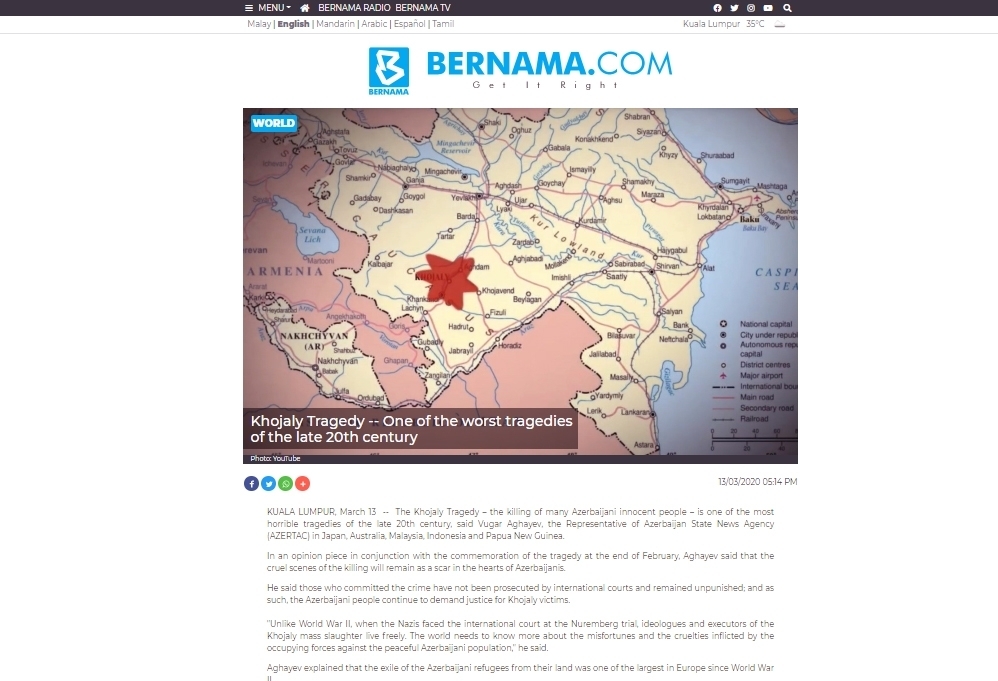



Bernama agency publishes AZERTAC special correspondent’s interview on Khojaly genocide

Kula Lumpur, March 14, AZERTAC
The Malaysian national news agency Bernama has published an article featuring the interview with AZERTAC’s special correspondent Vugar Aghayev who highlighted the Khojaly genocide committed by the Armenian armed forces against the peaceful Azerbaijanis.
Headlined “Khojaly Tragedy - One of the worst tragedies of the late 20th century”, the article reads: “The Khojaly Tragedy – the killing of many Azerbaijani innocent people – is one of the most horrible tragedies of the late 20th century, said Vugar Aghayev, the representative of Azerbaijan State News Agency (AZERTAC) in Japan, Australia, Malaysia, Indonesia and Papua New Guinea.
Aghayev said that the cruel scenes of the killing will remain as a scar in the hearts of Azerbaijanis.
He said those who committed the crime have not been prosecuted by international courts and remained unpunished; and as such, the Azerbaijani people continue to demand justice for Khojaly victims.
"Unlike World War II, when the Nazis faced the international court at the Nuremberg trial, ideologues and executors of the Khojaly mass slaughter live freely. The world needs to know more about the misfortunes and the cruelties inflicted by the occupying forces against the peaceful Azerbaijani population," he said.
Aghayev explained that the exile of the Azerbaijani refugees from their land was one of the largest in Europe since World War II.
Every year, at the end of February, the Azerbaijani people honour the memory of the victims of Khojaly Tragedy, which happened on the night of February 25 to February 26, 1992.
It refers to the killing of 613 ethnic Azerbaijani civilians in February 1992 in Khojaly, a small town in the Nagorno-Karabakh region.
According to Azerbaijan government's statistics, the number included 106 women, 63 children and 70 elderly people. Besides that, 1,275 people were taken as hostages while 150 more are still missing. The government also said that more than one million Azerbaijanis became refugees and internally displaced persons due to the Armenian occupation.
Aghayev said Khojaly was choosen as the target because apart from the strategic objectives, the intention was also to destroy Khojaly as a settlement that reflects the historical and cultural heritage of the city.
"This culture is known as the Khojaly-Gadabay culture and dates back to the 16th century BCE. Khojaly, one of the ancient settlements of Azerbaijan, was ruined and burned in one night," he said.
"The Khojaly civilian population was massacred because they were Azerbaijanis. One group of refugees managed to cross the river. They were soaked to the skin, and though they tried to hide in the nearby mountains, most of them died of hypothermia by morning," recalled Aghayev.
Aghayev pointed out that the massacre at Khojaly contravened international law, violated the Geneva conventions and articles 2, 3, 5, 9, and 17 of the Declaration of Human Rights (adopted by the UN General Assembly on December 10, 1948).
The conflict between the two countries started in 1988 – three years before the dissolution of the Soviet Union in 1991 – following Armenia’s territorial claims against Azerbaijan.
And in 1992, war broke out between the two former Soviet states, resulting in Armenia’s occupation of 20 per cent of Azerbaijan’s territory, including Nagorno-Karabakh and seven surrounding districts.
Malaysia was among the countries which have supported United Nations’ resolutions adopted during the conflict, which, among others, reaffirmed Azerbaijan’s territorial integrity.”
31 years pass since the Bashlibel tragedy, one of the bloodiest pages of our history
Azerbaijan's Foreign Ministry issues statement on March 31 – Day of Genocide of Azerbaijanis
Krakow Azerbaijani House commemorates victims of Khojaly genocide
Khojaly genocide victims commemorated in Mexico
Scottish University of Aberdeen commemorates 32nd anniversary of Khojaly Genocide